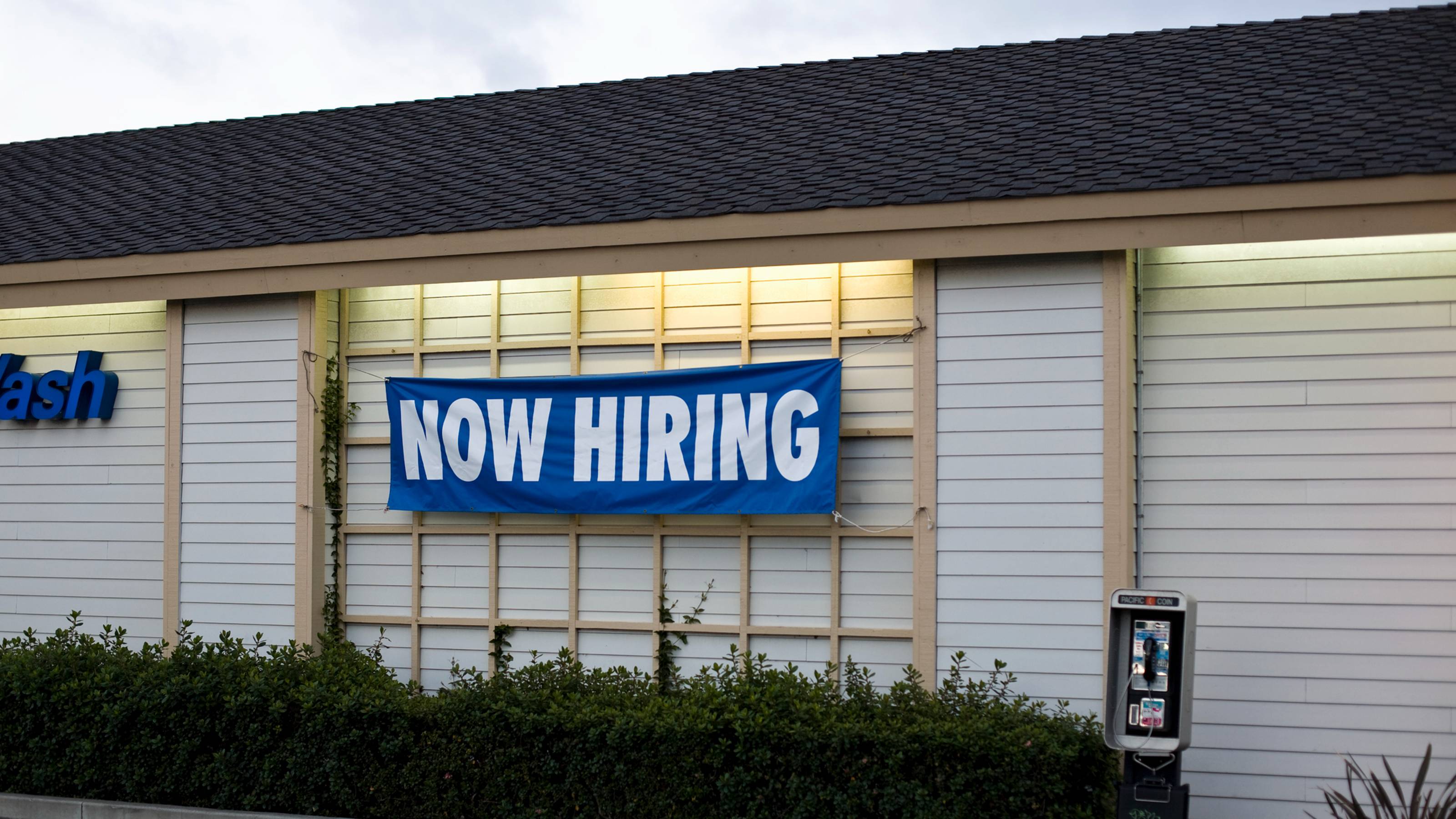Jobs Report Shows Pace of Hiring Slowed in March: What the Experts Are Saying
The jobs report showed the lowest level of hiring in more than two years.


The March jobs report showed the pace of hiring slowed to the lowest level in more than two years, relieving at least some pressure on the Federal Reserve to raise interest rates at the next Fed meeting.
Nonfarm payrolls expanded by 236,000 last month, or less than the 239,000 economists had forecast, the Bureau of Labor Statistics said Friday. Over the past six months, the economy has added an average of 334,000 jobs per month. March's figures are a sign that the Fed's efforts to combat inflation by introducing slack into the squeaky-tight labor market via an aggressive campaign of interest rate hikes might be beginning to have their intended effect.
The January jobs report figures were revised down by 32,000 – to 472,000 from 504,000 – but the February jobs report numbers were revised up by 15,000 – to 326,000 from 311,000. With those revisions, employment in January and February combined was 17,000 lower than previously reported, the BLS said.

Sign up for Kiplinger’s Free E-Newsletters
Profit and prosper with the best of expert advice on investing, taxes, retirement, personal finance and more - straight to your e-mail.
Profit and prosper with the best of expert advice - straight to your e-mail.
Although hiring slowed last month to the lowest level since December 2020, the 236,000 new jobs created was still well above the 183,000 monthly average recorded between 2010 and 2019. It was also higher than the 100,000 per month required to keep up with the increase in the working age population.
The strongest areas of hiring were found in leisure and hospitality, government, professional and business services, and healthcare.
The unemployment rate, which is derived from a separate survey, ticked down to 3.5% from 3.6% to remain at 50-year lows.
Average hourly earnings – another key data point for the Fed – rose by 0.3% month-over-month, which was in line with economists' forecasts. Over the past 12 months, average hourly earnings increased by 4.2%, which was below estimates for wage growth of 4.3%.
With the February jobs report now a matter of record, we turned to economists, strategists and other experts for their thoughts on what the data means for markets, macroeconomics and monetary policy going forward. Please see a selection of their commentary, sometimes edited for brevity or clarity, below.
Jobs report: the experts weigh in

"March’s jobs growth was the smallest monthly increase since December 2020, but was still a good increase. Labor market imbalances are becoming less of a concern for the Fed, but inflation is still running way too high. The Fed will more likely than not hold their target rate unchanged at the next decision in early May, but an upside surprise from next week’s inflation reports could tip the balance toward a final quarter percentage point hike of this cycle." – Bill Adams, chief economist at Comerica Bank
"Wage growth is slowing and should release some of the pressure on policy makers concerned about a wage-price spiral. The Fed will likely hike one more time to cool the economy as long as they do not see systemic risks within the banking sector." – Jeffrey Roach, chief economist at LPL Financial
"This month's jobs numbers could be a sign that the economy is slightly slowing down in reaction to the Fed's aggressive rate hikes or fears over instability in the banking sector. Even with these wider signs of an economic slowdown, we expect the unemployment rate to remain low for the coming months and anticipate that unemployment will rise to its natural long-run rate of 4.5% over the next two years." – Steve Rick, chief economist at CUNA Mutual Group
"This report, paired with the Job Openings report, shows that we're not in a hiring slowdown, but rather a pare-down of creating new openings. As the economy softens, employers are weighing their options and hesitant to create new positions, but they're still filling all of those positions they were unable to fill in the last two years. We are getting close to full employment, and this is happening in a softening economy. There are now 20 states with an unemployment rate of 3% or less, and the prime working age employment rate is the highest in over 20 years, at 80.7%." – Andrew Crapuchettes, CEO at RedBalloon
"Employment growth remained strong in March even though it slowed down compared to February of this year. The rate of unemployment came down even as the labor force participation rate increased further. The reason for this was that the household survey saw an increase in employment of 577,000 but the labor force increased by only 480,000. Thus, even though the labor force participation moved higher, the strength in employment pushed the rate of unemployment lower. This employment report is a mixed bag for the Federal Reserve, as the labor force participation rate continued to improve but the labor market tightened once again." – Eugenio Alemán, chief economist at Raymond James
"The March jobs report confirms that while progress continues on the inflation front, there is more work to be done. Job growth decelerated and labor force participation ticked up, both of which point to easing labor market tensions. However, hiring continues at a solid pace and there is no sign of the labor market slack that the Federal Reserve believes is needed to dent inflation. While more rate hikes may be in store, the good news is that there are no signs in the labor market yet that a recession is imminent." – Curt Long, chief economist and vice president of research at the National Association of Federally-Insured Credit Unions
"The labor market continues to show resilience despite the Fed's efforts to tame inflation by raising interest rates. Today's report should not deter the Fed from continuing its efforts to bring inflation to its target zone." – Eric Merlis, managing director, co-head of global markets at Citizens Bank
"The Fed will take a little comfort from decelerating employment in the past two months and some easing in wage growth, but the low unemployment rate and continued above-normal pace of job growth likely tips the scales toward another rate hike in May." – Sal Guatieri, senior economist at BMO Capital Markets
"At face value, the headline payroll number was largely in line with forecasts, but reading between the lines the moderate declines in specific sectors such as manufacturing and construction should be an encouraging sign to the Fed some effects of monetary policy are starting to take hold. This was another month where many of the job additions were absorbed in the leisure and hospitality sector, which is reflective of the strength we have seen on the service side of the economy. Overall, the latest read from this employment data shouldn’t do much to sway the Fed in either direction, but taken in conjunction with recent job openings data and weaker survey based data, the argument for a pause in rate hikes is building." –
Charlie Ripley, senior investment strategist at Allianz Investment Management
"So all in all this was a mixed employment number. The headline payrolls number was in line, led by continued strong state and local government hiring. Average hourly earnings were a little bit soft which should take a little pressure off of the Fed. The really strong part of the number was the Household Survey. It showed big job gains. Remember this has been underperforming the establishment survey for a while, so this is likely some catch up. Like mentioned above, people had expected a weak number after a series of disappointing releases so far this month so even a mixed number looks strong in that context. Looks like the market is leaning towards a 25 basis point [0.25%] hike in May, with approximately 17 basis points priced in, and the terminal rate back above 5%" – John Luke Tyner, portfolio manager and fixed-income analyst at Aptus Capital Advisors
"The larger trend in labor is definitely in decline in the total numbers from January to March, however the unemployment rate remains static at 3.5% because now the labor force participation rate is back to the same level as March 2020, or 62.6%." – Brian Mulberry, client portfolio manager at Zacks Investment Management
"The U.S. economy continued to add jobs at a brisk pace in March, with a still-strong labor market showing some signs of cooling in just the right places. Labor force participation bounced higher in March, and wage growth continued to moderate, providing welcome signs for policymakers at the Federal Reserve." – Jesse Wheeler, economic analyst at Morning Consult
"Hiring in the U.S. economy is slowing but not collapsing. The labor market is moving back toward balance not just through weaker labor demand, as has been evident in earlier reports on job openings and layoffs, but also through improving labor supply. On balance, this is the type of employment report we believe policymakers at the Federal Open Market Committee (FOMC) want to see: job growth slowing in an orderly fashion, labor supply expanding and wage growth that is edging closer to rates that are consistent with the central bank's 2% inflation target. We remain of the view that the FOMC will hike the fed funds rate by 25 basis points at its May 3 meeting, but it could be the last rate hike of the cycle as policymakers keep rates on hold for an extended period of time and let the medicine take." – Sarah House, senior economist at Wells Fargo Economics
Get Kiplinger Today newsletter — free
Profit and prosper with the best of Kiplinger's advice on investing, taxes, retirement, personal finance and much more. Delivered daily. Enter your email in the box and click Sign Me Up.

Dan Burrows is Kiplinger's senior investing writer, having joined the august publication full time in 2016.
A long-time financial journalist, Dan is a veteran of MarketWatch, CBS MoneyWatch, SmartMoney, InvestorPlace, DailyFinance and other tier 1 national publications. He has written for The Wall Street Journal, Bloomberg and Consumer Reports and his stories have appeared in the New York Daily News, the San Jose Mercury News and Investor's Business Daily, among many other outlets. As a senior writer at AOL's DailyFinance, Dan reported market news from the floor of the New York Stock Exchange.
Once upon a time – before his days as a financial reporter and assistant financial editor at legendary fashion trade paper Women's Wear Daily – Dan worked for Spy magazine, scribbled away at Time Inc. and contributed to Maxim magazine back when lad mags were a thing. He's also written for Esquire magazine's Dubious Achievements Awards.
In his current role at Kiplinger, Dan writes about markets and macroeconomics.
Dan holds a bachelor's degree from Oberlin College and a master's degree from Columbia University.
Disclosure: Dan does not trade individual stocks or securities. He is eternally long the U.S equity market, primarily through tax-advantaged accounts.
-
 6 Stunning Waterfront Homes for Sale Around the US
6 Stunning Waterfront Homes for Sale Around the USFrom private peninsulas to lakes, bayous and beyond, Kiplinger's "Listed" series brings you another selection of dream homes for sale on the waterfront.
By Charlotte Gorbold Published
-
 Six Reasons to Disinherit Someone and How to Do It
Six Reasons to Disinherit Someone and How to Do ItWhether you're navigating a second marriage, dealing with an estranged relative or leaving your assets to charity, there are reasons to disinherit someone. Here's how.
By Donna LeValley Published